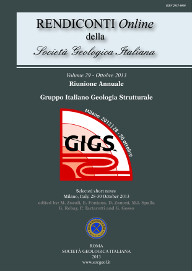
Finite element modelling of active structures in the Val d’Agri area (southern Apennines)
Stefano Santini (a), Stefania Candela (a), Stefano Mazzoli (b) & Antonella Megna (c)
(a) Department of basic and foundations Sciences (DiSBeF), University of Urbino, Via Santa Chiara 27, 61029 Urbino, Italy. E-mail: santini@fis.uniurb.it
(b) Department of earth sciences, environmental and resources, (DiSTAR), University of Naples Federico II, Largo San Marcellino 10, 80138 Naples, Italy.
(c) National Institute of Geophysics and Volcanology (INGV), Via di Vigna Murata, 60500143 Roma, Italy.
DOI: https://doi.org/
Volume: 29/2013
Pages: 154-157
Abstract
Finite element modelling by means of MSC. Marc software has been used to gain new insights into the deep structure of the southern Apennines, particularly concerning the geometry and kinematics of fault systems controlling active deformation and seismicity.
The Apennine accretionary wedge forms an allochthonous mass overlying foreland strata continuous with those exposed in the Apulian promontory. The tectonically buried portion of the Apulian Platform was involved in the final shortening phases, giving rise to reverse-fault-related, open, long-wavelength folds that form the hydrocarbon traps for the oil discoveries in southern Italy. Recent geophysical studies have provided evidence that deep-seated reverse faulting involves the basement, while interpretation of high-quality seismic profiles and cross-section balancing favour an inversion tectonics model involving reactivation of pre-existing (Permo-Triassic) basement normal faults, the related deformation being characterized by limited horizontal displacements.
Our work suggests an important role of the mélange zone interposed between the buried Apulian Platform carbonates and the surface allochthnous units in producing effective decoupling between deep and shallow structural levels. While the former are dominated by deeply rooted major faults, surface units are dissected by numerous brittle structures that formed at various stages during Apennines evolution. As a result of late Quaternary extensional reactivation of the deep-seated major faults, the inherited fault network characterizing the shallow rigid lid (decoupled by the ductile mélange zone at its base) is reactivated in a complex fashion. This results in a highly segmented and articulated fault pattern. On the other hand, major brittle structures in the buried Apulian Platform carbonates and underlying basement represent mature fault zone that cumulated displacements of up to a few kilometres over geologic time. As such, they are capable of nucleating large earthquakes as a result of late Quaternary extensional reactivation. The role of these important discontinuities, as well as of thickness variations of different crustal layers, is emphasized by our finite element modelling, which effectively outlines stress perturbations and strain field around main active structures.
Keywords
Get Full Text